Austrian actor Paul Richter (1895-1961) starred in several silent films directed by Joe May and Fritz Lang. He became an idol of the 1920s with the lushly produced Ufa production Die Nibelungen (Fritz Lang, 1924).

German postcard by Ross Verlag, Berlin, no. 672/1, 1924. Photo: Decla-Ufa-Film. Paul Richter in Die Nibelungen: Siegfried (Fritz Lang, 1924).

German postcard by Ross Verlag, Berlin, no. 26/4. Photo: Ufa. Paul Richter in Pietro der Korsar/Peter the Pirate (Arthur Robison, 1925).

German postcard by Ross Verlag, Berlin, no. 475/2, 1919-1924. Photo: A. Eberth, Berlin.

German postcard by Ross Verlag, Berlin, no. 800/1, 1925-1926.

German postcard by Ross Verlag, Berlin, no. 1657/1, 1927-1928. Photo: Phoebus Film.
Paul Martin Edward Richter was born in Vienna, Austria in 1895. In 1914, he made his film debut with the short silent film Sterbewalzer/Death Waltz (1914), followed by Die Gouvernante/The Governess (1914).
The outbreak of the First World War halted temporarily his film activities. He became an 'emperor hunter' in the Carpathians, and later he was detached to a mountain guide course. Nature and the mountains with which he became familiar on the occasion, found a fixed place in his life and later also in his films.
After WWI, he became famous with the fancy adventure film Das indische Grabmal/The Indian Tomb (Joe May, 1921) starring Olaf Fönss and Mia May.
Another success was the thriller Dr. Mabuse, der Spieler/Dr. Mabuse, the Gambler (Fritz Lang, 1922) with Rudolf Klein-Rogge and Norwegian actress Aud Egede-Nissen, with whom he soon married.
His next film for director Fritz Lang made him a German idol of the 1920s. In Die Nibelungen (Fritz Lang, 1924) he starred as the hero Siegfried.
Thomas Staedeli writes at Cyranos that Richter became a sex symbol of the 1920s: "At last Germany was able to present a pendant to the American stars Ramon Novarro and Rudolph Valentino."

German postcard by Ross Verlag, Berlin, no. 675/1, 1924. Photo: Decla-Ufa-Film. Paul Richter in Die Nibelungen: Siegfried (Fritz Lang, 1924).
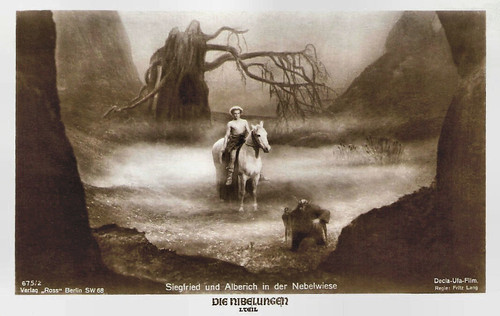
German postcard by Ross Verlag, Berlin, no. 675/2. Photo: Decla-Ufa-Film. Publicity still for Die Nibelungen: Siegfried (Fritz Lang, 1924). Siegfried and Alberich (Georg John) in the fog meadow.
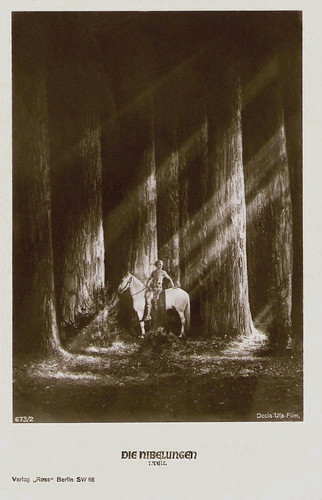
German postcard by Ross Verlag, Berlin, no. 673/2. Photo: Decla-Ufa-Film. Publicity still for Die Nibelungen: Siegfried (Fritz Lang, 1924). Siegfried in the woods.
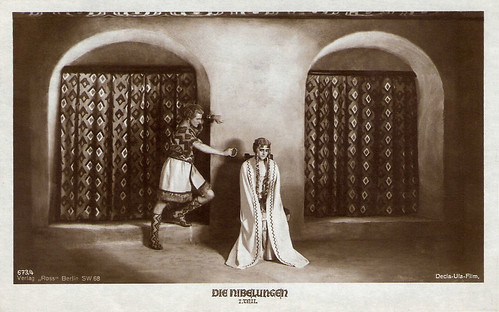
German postcard by Ross Verlag, Berlin, no. 673/4. Photo: Decla-Ufa-Film. Publicity still for Die Nibelungen: Siegfried (Fritz Lang, 1924). Siegfried presents Kriemhild (Margarete Schön) the circlet.
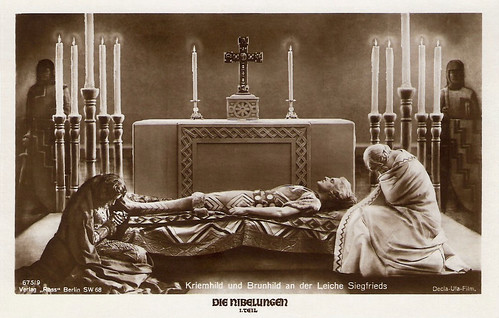
German postcard by Ross Verlag, Berlin, no. 675/9. Photo: Decla-Ufa-Film. Publicity still for Die Nibelungen: Siegfried (Fritz Lang, 1924). Kriemhild (Margarete Schön) and Brunhilde (Hanna Ralph) with the corpse of Siegfried.
Die Nibelungen is a duology of silent fantasy films: the first part is Die Nibelungen: Siegfried and the second part is Die Nibelungen: Kriemhilds Rache/Kriemhild's Revenge. They were based upon the epic Nordic poem 'Nibelungenlied', written around AD 1200. The screenplay was written by Fritz Lang and his wife at the time, Thea von Harbou.
During the shooting of the film, there were often arguments between director Lang and his star actor. This found its peak when Richter had to present himself nude in front of the camera for the bath scene in the blood of the dragon.
Because Richter refused to play this part without swimming trunks, Lang finished the scene with Rudolf Klein-Rogge.
More than 80 years later, Die Nibelungen is still astounding to look at. Lang gave the film a real sense of wonder by way of fantasy elements such as dwarfs, dragons, and magic powers.
The standout scene is the dragon-slaying scene with its wonderful special effects. In retrospect, it's amazing that such a masterpiece of cinema could have been made in the early 1920s.

German postcard by Ross Verlag, Berlin, no. 992/1, 1925-1926. Photo: Ufa. Paul Richter in Pietro der Korsar/Peter the Pirate (Arthur Robison, 1925).

German postcard by Ross Verlag, Berlin, no. 1024/1, 1927-1928. Photo: Ufa. Paul Richter in Pietro der Korsar/Peter the Pirate (Arthur Robison, 1925).

German postcard by Ross Verlag, no. 1024/2. Photo: Ufa. Paul Richter in Pietro der Korsar/Peter the Pirate (Arthur Robison, 1925).

German postcard by Ross Verlag, Berlin, no. 1024/4, 1927-1928. Photo: Ufa. Paul Richter and Aud Egede Nissen in Pietro der Korsar/Peter the Pirate (Arthur Robison, 1925).

Russian postcard.
After the enormous success of Die Nibelungen, Paul Richter was soon cast again as a half-nude hero in Pietro, der Korsar/Peter the Pirate (Arthur Robison, 1925) opposite his wife, Aud Egede-Nissen.
They also appeared together in Die rote Maus/The Red Mouse (Rudolf Meinert, 1926), the comedy Kampf der Geschlechter/Clash of the gender (Heinrich Brandt, 1926) and Schwester Veronica/Sister Veronica (Gerhard Lamprecht, 1927).
Other silent films were Dagfin (Joe May, 1926) and the British-German coproduction The Queen Was in the Parlour (Graham Cutts, 1927) featuring Lily Damita.

German postcard by Ross Verlag, Berlin, no. 862/2, 1925-1926. Photo: Becker & Maas, Berlin.
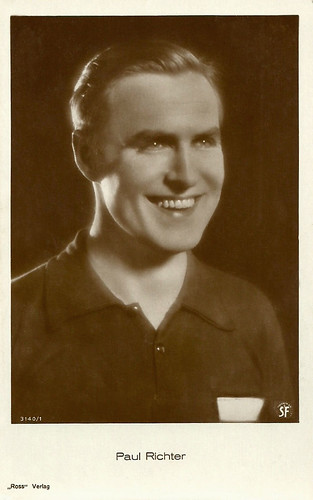
German postcard by Ross Verlag, no. 3140/1, 1928-1929. Photo: SF.

German postcard by Ross Verlag, no. 3140/2, 1928-1929. Photo: SF.

German postcard by Ross Verlag, no. 3348/3, 1928-1929. Photo: Orpid Messtro Film.

German postcard by Ross Verlag, no. 5576/1, 1930-1931. Photo: Transocean-Film. Paul Richter as Kaiser Josef in Die Försterchristl/The Forester's Daughter (Friedrich Zelnik, 1931).
In the early 1930s Paul Richter was often cast in Heimatfilms, films with a regional background like Die Försterchristel (Friedrich Zelnik, 1931) and Schloss Hubertus/Hubertus Castle (Hans Deppe, 1934) opposite Hansi Knoteck.
From then on he usually played huntsmen, foresters or landowners in such films as Der Jäger von Fall/The Hunter of Fall (Hans Deppe, 1936), Das Schweigen im Walde/Silence of the Forest (Hans Deppe, 1937) and Der Edelweißkönig/King of the Edelweiss (Paul May, 1939), again opposite Hansi Knoteck.
Thomas Staedeli notes that Richter was able to bring real life into these performances "because of his private preference for nature and the mountains" in contrast to successors like Rudolf Prack in the 1950s.
A difficult eye operation ended Richter's career at the end of the 195's. His final film was Wetterleuchten um Maria/Lightning around Maria (Luis Trenker, 1959) starring Marianne Hold. Paul Richter died in 1961 in his home in Vienna. He was the stepfather of actor Georg Richter.

German flyer by Illustrierte Film-Kurier, no. 1168, 1952, part 1. Das Testament des Dr. Mabuse/The Testament of Dr. Mabuse (Fritz Lang, 1933).
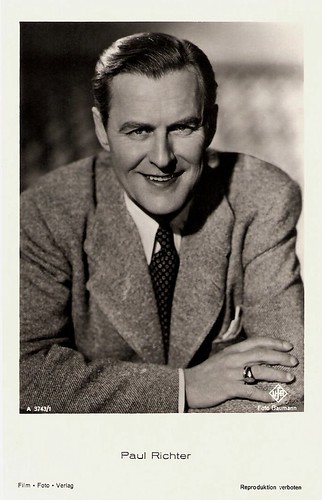
German postcard by Film-Foto-Verlag, no. A 3743/1, 1941-1944. Photo: Baumann / Ufa.

German postcard by Das Programm von Heute, Berlin. Photo: Tobis. Collection: Miss Mertens.

German postcard by Das Programm von Heute, Berlin. Photo: Ufa / Baumann. Collection: Miss Mertens.
Siegfried slays the dragon in Die Nibelungen (1924). Source: OperaPeru (YouTube).
Sources: Thomas Staedeli (Cyranos), Wikipedia, and IMDb.

German postcard by Ross Verlag, Berlin, no. 672/1, 1924. Photo: Decla-Ufa-Film. Paul Richter in Die Nibelungen: Siegfried (Fritz Lang, 1924).

German postcard by Ross Verlag, Berlin, no. 26/4. Photo: Ufa. Paul Richter in Pietro der Korsar/Peter the Pirate (Arthur Robison, 1925).

German postcard by Ross Verlag, Berlin, no. 475/2, 1919-1924. Photo: A. Eberth, Berlin.

German postcard by Ross Verlag, Berlin, no. 800/1, 1925-1926.

German postcard by Ross Verlag, Berlin, no. 1657/1, 1927-1928. Photo: Phoebus Film.
A Sex Symbol of the 1920s
Paul Martin Edward Richter was born in Vienna, Austria in 1895. In 1914, he made his film debut with the short silent film Sterbewalzer/Death Waltz (1914), followed by Die Gouvernante/The Governess (1914).
The outbreak of the First World War halted temporarily his film activities. He became an 'emperor hunter' in the Carpathians, and later he was detached to a mountain guide course. Nature and the mountains with which he became familiar on the occasion, found a fixed place in his life and later also in his films.
After WWI, he became famous with the fancy adventure film Das indische Grabmal/The Indian Tomb (Joe May, 1921) starring Olaf Fönss and Mia May.
Another success was the thriller Dr. Mabuse, der Spieler/Dr. Mabuse, the Gambler (Fritz Lang, 1922) with Rudolf Klein-Rogge and Norwegian actress Aud Egede-Nissen, with whom he soon married.
His next film for director Fritz Lang made him a German idol of the 1920s. In Die Nibelungen (Fritz Lang, 1924) he starred as the hero Siegfried.
Thomas Staedeli writes at Cyranos that Richter became a sex symbol of the 1920s: "At last Germany was able to present a pendant to the American stars Ramon Novarro and Rudolph Valentino."

German postcard by Ross Verlag, Berlin, no. 675/1, 1924. Photo: Decla-Ufa-Film. Paul Richter in Die Nibelungen: Siegfried (Fritz Lang, 1924).

German postcard by Ross Verlag, Berlin, no. 675/2. Photo: Decla-Ufa-Film. Publicity still for Die Nibelungen: Siegfried (Fritz Lang, 1924). Siegfried and Alberich (Georg John) in the fog meadow.

German postcard by Ross Verlag, Berlin, no. 673/2. Photo: Decla-Ufa-Film. Publicity still for Die Nibelungen: Siegfried (Fritz Lang, 1924). Siegfried in the woods.

German postcard by Ross Verlag, Berlin, no. 673/4. Photo: Decla-Ufa-Film. Publicity still for Die Nibelungen: Siegfried (Fritz Lang, 1924). Siegfried presents Kriemhild (Margarete Schön) the circlet.

German postcard by Ross Verlag, Berlin, no. 675/9. Photo: Decla-Ufa-Film. Publicity still for Die Nibelungen: Siegfried (Fritz Lang, 1924). Kriemhild (Margarete Schön) and Brunhilde (Hanna Ralph) with the corpse of Siegfried.
Wonderful Special Effects
Die Nibelungen is a duology of silent fantasy films: the first part is Die Nibelungen: Siegfried and the second part is Die Nibelungen: Kriemhilds Rache/Kriemhild's Revenge. They were based upon the epic Nordic poem 'Nibelungenlied', written around AD 1200. The screenplay was written by Fritz Lang and his wife at the time, Thea von Harbou.
During the shooting of the film, there were often arguments between director Lang and his star actor. This found its peak when Richter had to present himself nude in front of the camera for the bath scene in the blood of the dragon.
Because Richter refused to play this part without swimming trunks, Lang finished the scene with Rudolf Klein-Rogge.
More than 80 years later, Die Nibelungen is still astounding to look at. Lang gave the film a real sense of wonder by way of fantasy elements such as dwarfs, dragons, and magic powers.
The standout scene is the dragon-slaying scene with its wonderful special effects. In retrospect, it's amazing that such a masterpiece of cinema could have been made in the early 1920s.

German postcard by Ross Verlag, Berlin, no. 992/1, 1925-1926. Photo: Ufa. Paul Richter in Pietro der Korsar/Peter the Pirate (Arthur Robison, 1925).

German postcard by Ross Verlag, Berlin, no. 1024/1, 1927-1928. Photo: Ufa. Paul Richter in Pietro der Korsar/Peter the Pirate (Arthur Robison, 1925).

German postcard by Ross Verlag, no. 1024/2. Photo: Ufa. Paul Richter in Pietro der Korsar/Peter the Pirate (Arthur Robison, 1925).

German postcard by Ross Verlag, Berlin, no. 1024/4, 1927-1928. Photo: Ufa. Paul Richter and Aud Egede Nissen in Pietro der Korsar/Peter the Pirate (Arthur Robison, 1925).

Russian postcard.
Half-nude Hero
After the enormous success of Die Nibelungen, Paul Richter was soon cast again as a half-nude hero in Pietro, der Korsar/Peter the Pirate (Arthur Robison, 1925) opposite his wife, Aud Egede-Nissen.
They also appeared together in Die rote Maus/The Red Mouse (Rudolf Meinert, 1926), the comedy Kampf der Geschlechter/Clash of the gender (Heinrich Brandt, 1926) and Schwester Veronica/Sister Veronica (Gerhard Lamprecht, 1927).
Other silent films were Dagfin (Joe May, 1926) and the British-German coproduction The Queen Was in the Parlour (Graham Cutts, 1927) featuring Lily Damita.

German postcard by Ross Verlag, Berlin, no. 862/2, 1925-1926. Photo: Becker & Maas, Berlin.

German postcard by Ross Verlag, no. 3140/1, 1928-1929. Photo: SF.

German postcard by Ross Verlag, no. 3140/2, 1928-1929. Photo: SF.

German postcard by Ross Verlag, no. 3348/3, 1928-1929. Photo: Orpid Messtro Film.

German postcard by Ross Verlag, no. 5576/1, 1930-1931. Photo: Transocean-Film. Paul Richter as Kaiser Josef in Die Försterchristl/The Forester's Daughter (Friedrich Zelnik, 1931).
King of the Edelweiss
In the early 1930s Paul Richter was often cast in Heimatfilms, films with a regional background like Die Försterchristel (Friedrich Zelnik, 1931) and Schloss Hubertus/Hubertus Castle (Hans Deppe, 1934) opposite Hansi Knoteck.
From then on he usually played huntsmen, foresters or landowners in such films as Der Jäger von Fall/The Hunter of Fall (Hans Deppe, 1936), Das Schweigen im Walde/Silence of the Forest (Hans Deppe, 1937) and Der Edelweißkönig/King of the Edelweiss (Paul May, 1939), again opposite Hansi Knoteck.
Thomas Staedeli notes that Richter was able to bring real life into these performances "because of his private preference for nature and the mountains" in contrast to successors like Rudolf Prack in the 1950s.
A difficult eye operation ended Richter's career at the end of the 195's. His final film was Wetterleuchten um Maria/Lightning around Maria (Luis Trenker, 1959) starring Marianne Hold. Paul Richter died in 1961 in his home in Vienna. He was the stepfather of actor Georg Richter.

German flyer by Illustrierte Film-Kurier, no. 1168, 1952, part 1. Das Testament des Dr. Mabuse/The Testament of Dr. Mabuse (Fritz Lang, 1933).

German postcard by Film-Foto-Verlag, no. A 3743/1, 1941-1944. Photo: Baumann / Ufa.

German postcard by Das Programm von Heute, Berlin. Photo: Tobis. Collection: Miss Mertens.

German postcard by Das Programm von Heute, Berlin. Photo: Ufa / Baumann. Collection: Miss Mertens.
Siegfried slays the dragon in Die Nibelungen (1924). Source: OperaPeru (YouTube).
Sources: Thomas Staedeli (Cyranos), Wikipedia, and IMDb.
No comments:
Post a Comment